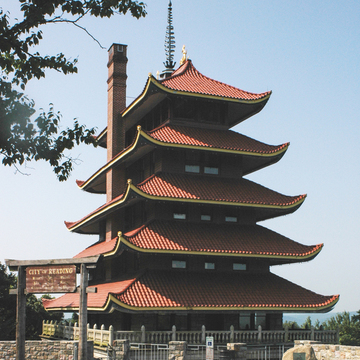Atop the west slope of Mount Penn and anchoring the historic open space given to the city by the Penn family is an astonishing landmark, a seven-stage tower commonly known as the “pagoda.” It takes its form from the Japanese battle castle at Negoya. Its presence overlooking Reading reveals the global reach of modern industrial cultures. Conceived to conceal the scar from stone quarrying that offended the citizens of Reading, the tower was intended as a hotel and restaurant that would offer spectacular views of the surrounding countryside. In the nineteenth century, several resorts made the mountain a popular destination because they could be reached by a gravity railroad. In 1908, an automobile road was built by Reading-based automobile manufacturer Charles Duryea to test his vehicles. When the resort owners could not get a liquor license—this is Pennsylvania, after all—they sold the property in 1910 to Jonathan Mould who gave it to the city of Reading. Visible from the pagoda is the Kittatinny Valley all the way to the northern Blue Mountain, with the city of Reading in the foreground. The structure was largely rebuilt in 1970 when the original wood shingles were replaced with clay tiles, but the remarkable anomaly of a Japanese battle castle above a Pennsylvania industrial city remains an exemplary image.
You are here
Mount Penn Pagoda
1909, Charles Matz; 1970 restored, Muhlenberg Greene Architects. End of Duryea Dr. and Skyline Blvd., Mt. Penn, 2 miles east of Reading
If SAH Archipedia has been useful to you, please consider supporting it.
SAH Archipedia tells the story of the United States through its buildings, landscapes, and cities. This freely available resource empowers the public with authoritative knowledge that deepens their understanding and appreciation of the built environment. But the Society of Architectural Historians, which created SAH Archipedia with University of Virginia Press, needs your support to maintain the high-caliber research, writing, photography, cartography, editing, design, and programming that make SAH Archipedia a trusted online resource available to all who value the history of place, heritage tourism, and learning.

